Strategic Management Report: Woolworths' Analysis, Course Name
VerifiedAdded on 2022/10/10
|12
|2877
|20
Report
AI Summary
This report provides a comprehensive strategic analysis of Woolworths, a major retail company in Australia and New Zealand. The analysis begins with an overview of the company's history, ownership, and market position, followed by a detailed examination of its macro-environment using the PESTLE framework, identifying key political, economic, social, technological, legal, and environmental factors influencing its operations. The report then applies Porter's Five Forces model to assess the competitive landscape, including the threats of new entrants and substitutes, the bargaining power of buyers and suppliers, and the intensity of rivalry among existing competitors. An internal analysis of Woolworths' strengths and weaknesses is conducted, including its brand recognition, customer loyalty programs, and operational efficiency. Finally, the report explores business-level strategies, including recommendations for enhancing customer relationships, introducing in-store services like childcare, and leveraging data analytics. The value chain analysis highlights key activities and support systems that contribute to Woolworths' competitive advantage, concluding with a call for strategic planning and performance monitoring to achieve long-term goals.
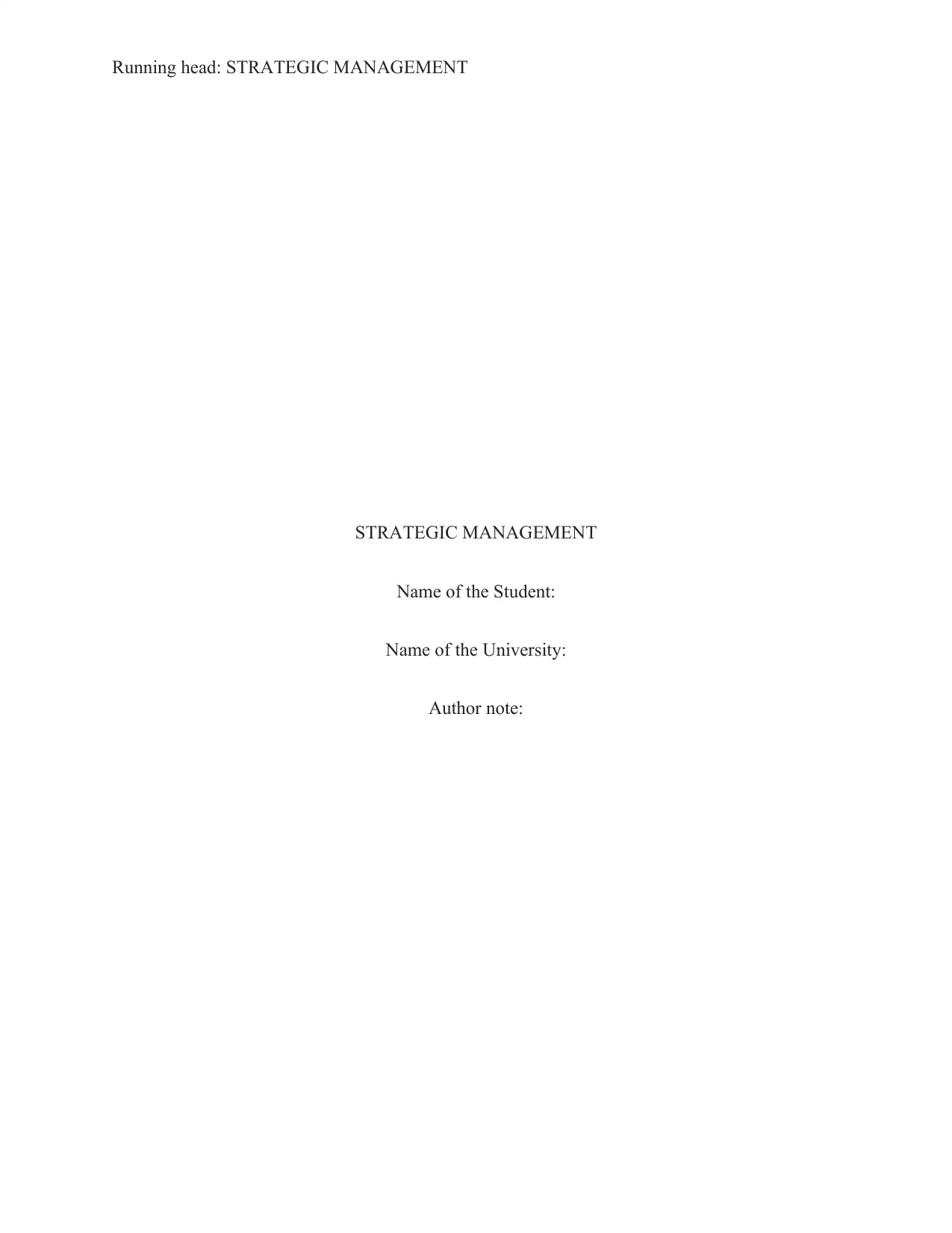
Running head: STRATEGIC MANAGEMENT
STRATEGIC MANAGEMENT
Name of the Student:
Name of the University:
Author note:
STRATEGIC MANAGEMENT
Name of the Student:
Name of the University:
Author note:
Paraphrase This Document
Need a fresh take? Get an instant paraphrase of this document with our AI Paraphraser
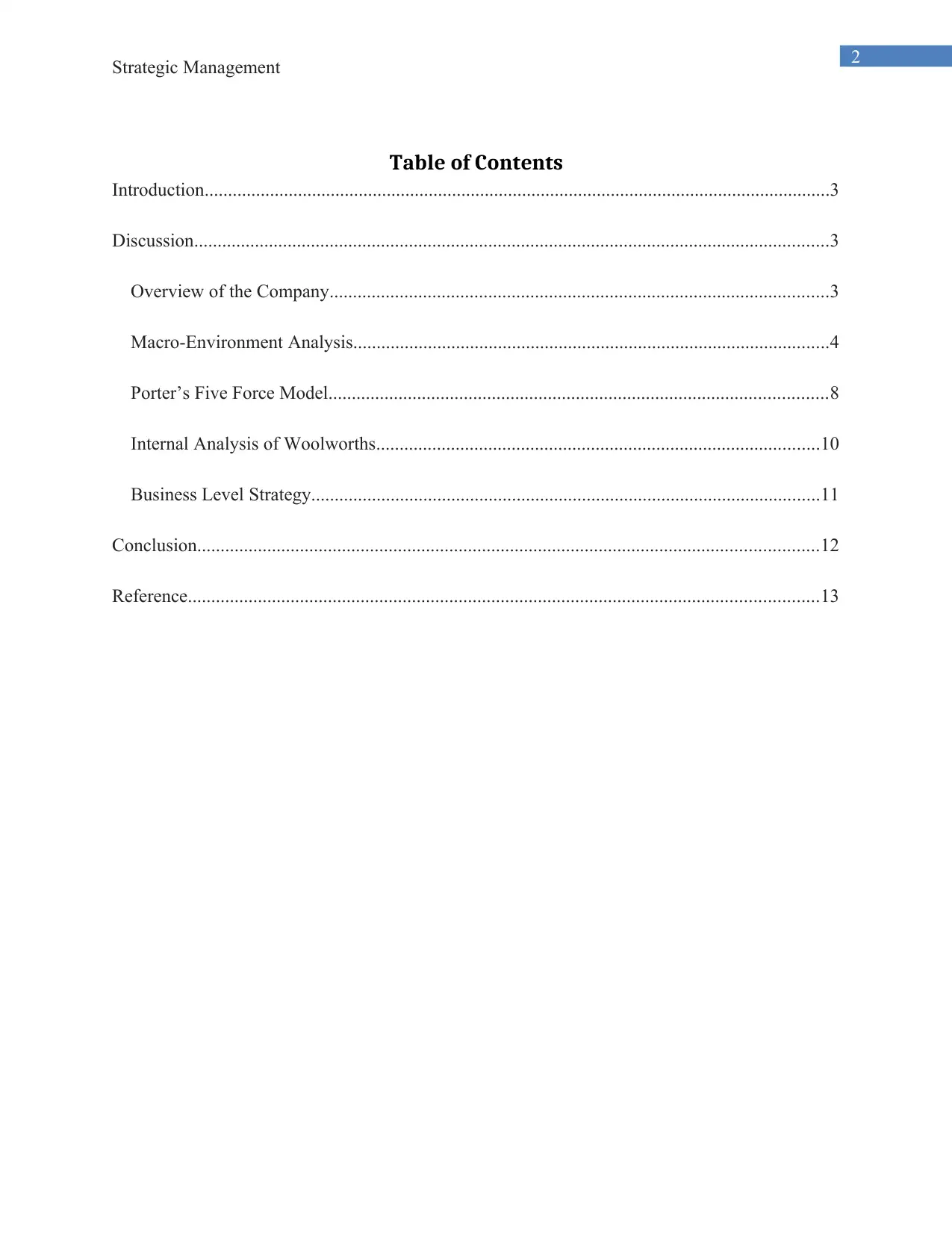
2
Strategic Management
Table of Contents
Introduction......................................................................................................................................3
Discussion........................................................................................................................................3
Overview of the Company...........................................................................................................3
Macro-Environment Analysis......................................................................................................4
Porter’s Five Force Model...........................................................................................................8
Internal Analysis of Woolworths...............................................................................................10
Business Level Strategy.............................................................................................................11
Conclusion.....................................................................................................................................12
Reference.......................................................................................................................................13
Strategic Management
Table of Contents
Introduction......................................................................................................................................3
Discussion........................................................................................................................................3
Overview of the Company...........................................................................................................3
Macro-Environment Analysis......................................................................................................4
Porter’s Five Force Model...........................................................................................................8
Internal Analysis of Woolworths...............................................................................................10
Business Level Strategy.............................................................................................................11
Conclusion.....................................................................................................................................12
Reference.......................................................................................................................................13
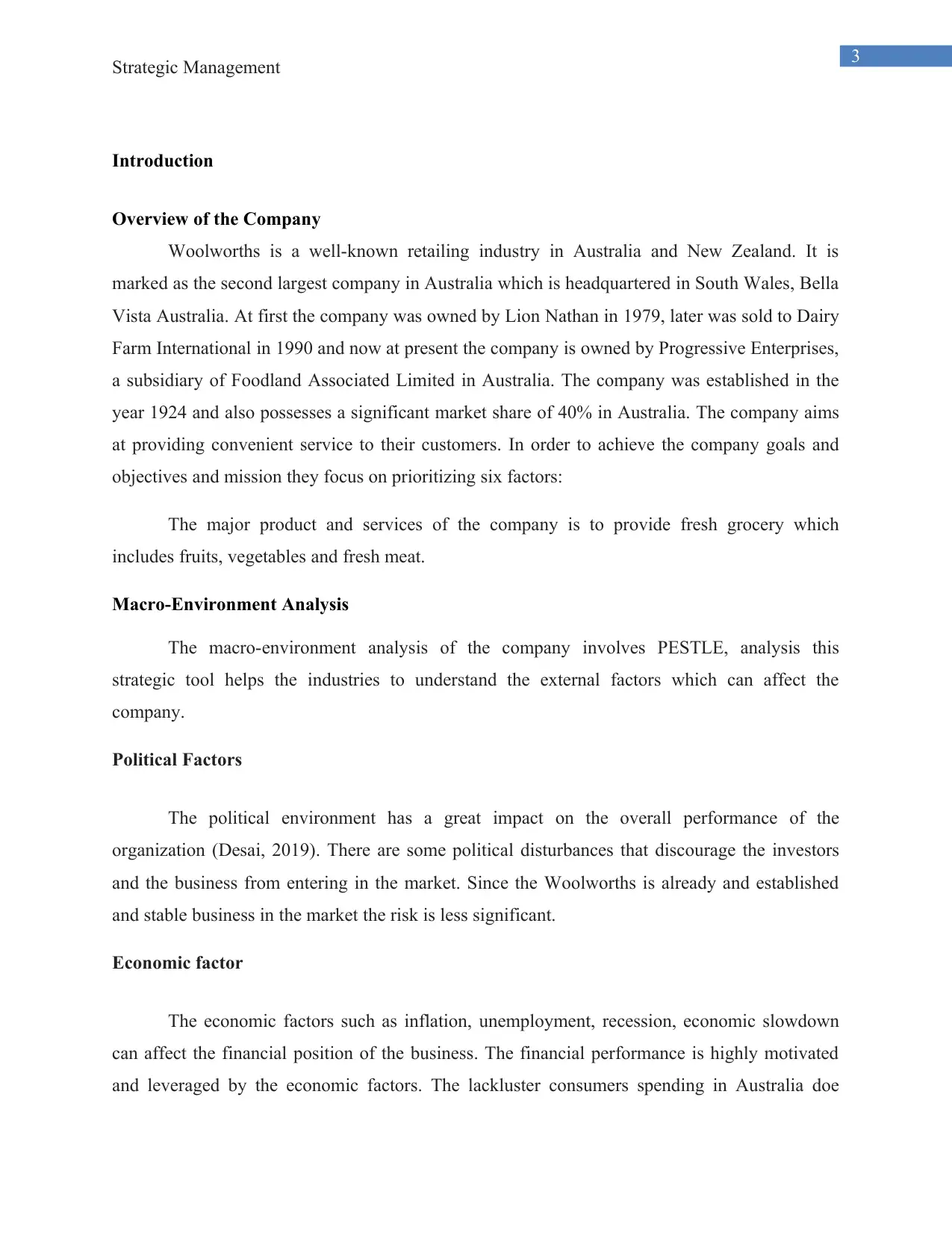
3
Strategic Management
Introduction
Overview of the Company
Woolworths is a well-known retailing industry in Australia and New Zealand. It is
marked as the second largest company in Australia which is headquartered in South Wales, Bella
Vista Australia. At first the company was owned by Lion Nathan in 1979, later was sold to Dairy
Farm International in 1990 and now at present the company is owned by Progressive Enterprises,
a subsidiary of Foodland Associated Limited in Australia. The company was established in the
year 1924 and also possesses a significant market share of 40% in Australia. The company aims
at providing convenient service to their customers. In order to achieve the company goals and
objectives and mission they focus on prioritizing six factors:
The major product and services of the company is to provide fresh grocery which
includes fruits, vegetables and fresh meat.
Macro-Environment Analysis
The macro-environment analysis of the company involves PESTLE, analysis this
strategic tool helps the industries to understand the external factors which can affect the
company.
Political Factors
The political environment has a great impact on the overall performance of the
organization (Desai, 2019). There are some political disturbances that discourage the investors
and the business from entering in the market. Since the Woolworths is already and established
and stable business in the market the risk is less significant.
Economic factor
The economic factors such as inflation, unemployment, recession, economic slowdown
can affect the financial position of the business. The financial performance is highly motivated
and leveraged by the economic factors. The lackluster consumers spending in Australia doe
Strategic Management
Introduction
Overview of the Company
Woolworths is a well-known retailing industry in Australia and New Zealand. It is
marked as the second largest company in Australia which is headquartered in South Wales, Bella
Vista Australia. At first the company was owned by Lion Nathan in 1979, later was sold to Dairy
Farm International in 1990 and now at present the company is owned by Progressive Enterprises,
a subsidiary of Foodland Associated Limited in Australia. The company was established in the
year 1924 and also possesses a significant market share of 40% in Australia. The company aims
at providing convenient service to their customers. In order to achieve the company goals and
objectives and mission they focus on prioritizing six factors:
The major product and services of the company is to provide fresh grocery which
includes fruits, vegetables and fresh meat.
Macro-Environment Analysis
The macro-environment analysis of the company involves PESTLE, analysis this
strategic tool helps the industries to understand the external factors which can affect the
company.
Political Factors
The political environment has a great impact on the overall performance of the
organization (Desai, 2019). There are some political disturbances that discourage the investors
and the business from entering in the market. Since the Woolworths is already and established
and stable business in the market the risk is less significant.
Economic factor
The economic factors such as inflation, unemployment, recession, economic slowdown
can affect the financial position of the business. The financial performance is highly motivated
and leveraged by the economic factors. The lackluster consumers spending in Australia doe
⊘ This is a preview!⊘
Do you want full access?
Subscribe today to unlock all pages.

Trusted by 1+ million students worldwide
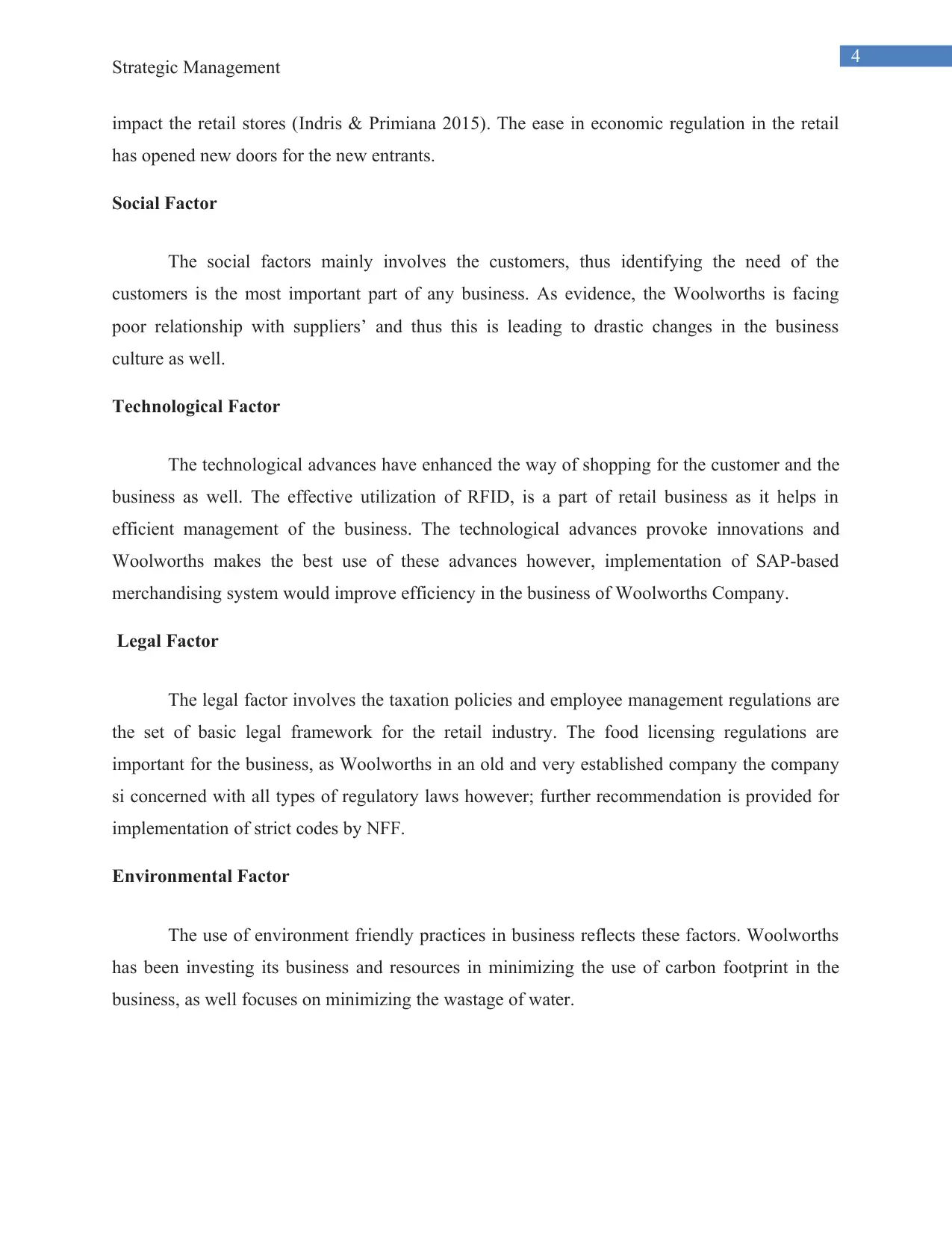
4
Strategic Management
impact the retail stores (Indris & Primiana 2015). The ease in economic regulation in the retail
has opened new doors for the new entrants.
Social Factor
The social factors mainly involves the customers, thus identifying the need of the
customers is the most important part of any business. As evidence, the Woolworths is facing
poor relationship with suppliers’ and thus this is leading to drastic changes in the business
culture as well.
Technological Factor
The technological advances have enhanced the way of shopping for the customer and the
business as well. The effective utilization of RFID, is a part of retail business as it helps in
efficient management of the business. The technological advances provoke innovations and
Woolworths makes the best use of these advances however, implementation of SAP-based
merchandising system would improve efficiency in the business of Woolworths Company.
Legal Factor
The legal factor involves the taxation policies and employee management regulations are
the set of basic legal framework for the retail industry. The food licensing regulations are
important for the business, as Woolworths in an old and very established company the company
si concerned with all types of regulatory laws however; further recommendation is provided for
implementation of strict codes by NFF.
Environmental Factor
The use of environment friendly practices in business reflects these factors. Woolworths
has been investing its business and resources in minimizing the use of carbon footprint in the
business, as well focuses on minimizing the wastage of water.
Strategic Management
impact the retail stores (Indris & Primiana 2015). The ease in economic regulation in the retail
has opened new doors for the new entrants.
Social Factor
The social factors mainly involves the customers, thus identifying the need of the
customers is the most important part of any business. As evidence, the Woolworths is facing
poor relationship with suppliers’ and thus this is leading to drastic changes in the business
culture as well.
Technological Factor
The technological advances have enhanced the way of shopping for the customer and the
business as well. The effective utilization of RFID, is a part of retail business as it helps in
efficient management of the business. The technological advances provoke innovations and
Woolworths makes the best use of these advances however, implementation of SAP-based
merchandising system would improve efficiency in the business of Woolworths Company.
Legal Factor
The legal factor involves the taxation policies and employee management regulations are
the set of basic legal framework for the retail industry. The food licensing regulations are
important for the business, as Woolworths in an old and very established company the company
si concerned with all types of regulatory laws however; further recommendation is provided for
implementation of strict codes by NFF.
Environmental Factor
The use of environment friendly practices in business reflects these factors. Woolworths
has been investing its business and resources in minimizing the use of carbon footprint in the
business, as well focuses on minimizing the wastage of water.
Paraphrase This Document
Need a fresh take? Get an instant paraphrase of this document with our AI Paraphraser
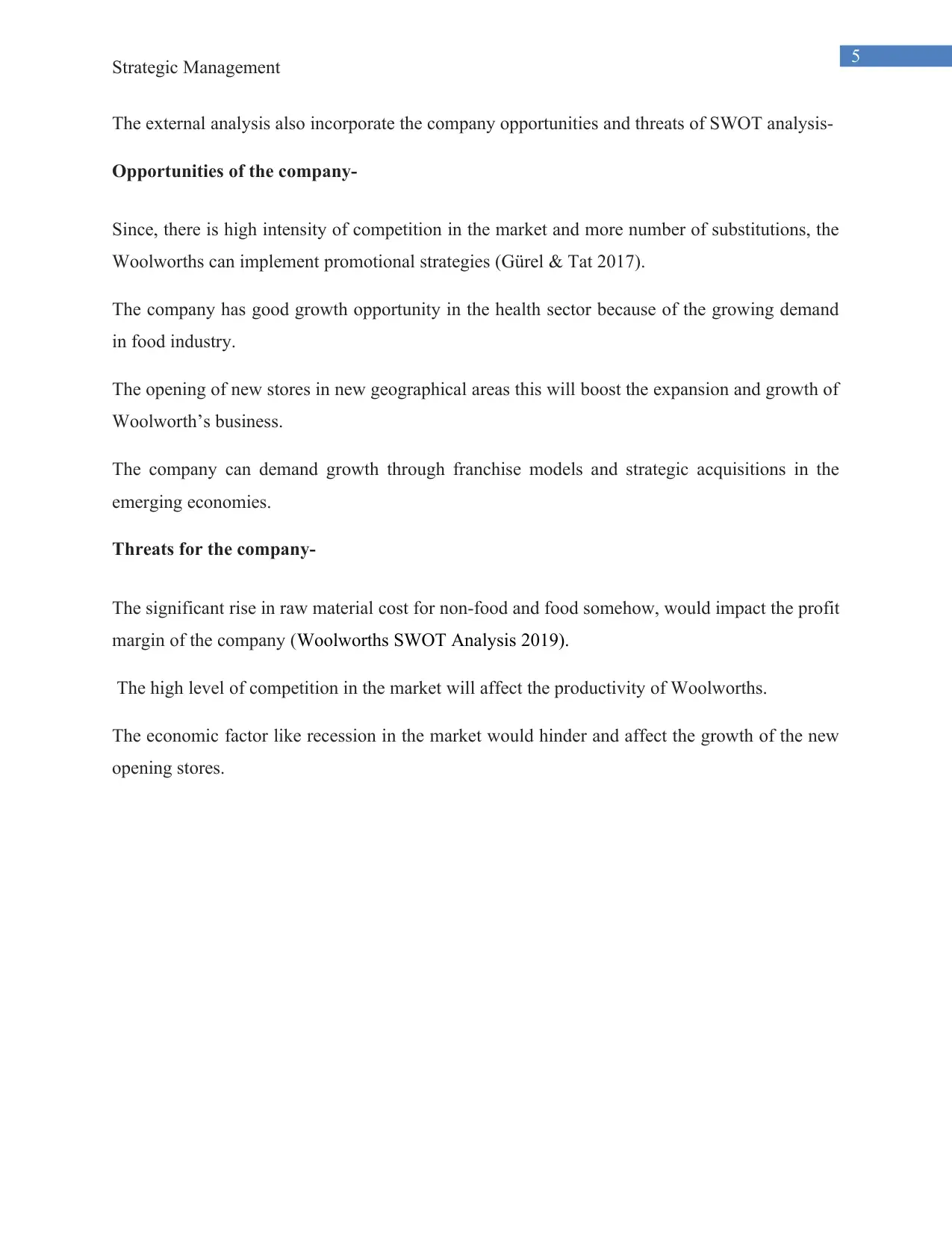
5
Strategic Management
The external analysis also incorporate the company opportunities and threats of SWOT analysis-
Opportunities of the company-
Since, there is high intensity of competition in the market and more number of substitutions, the
Woolworths can implement promotional strategies (Gürel & Tat 2017).
The company has good growth opportunity in the health sector because of the growing demand
in food industry.
The opening of new stores in new geographical areas this will boost the expansion and growth of
Woolworth’s business.
The company can demand growth through franchise models and strategic acquisitions in the
emerging economies.
Threats for the company-
The significant rise in raw material cost for non-food and food somehow, would impact the profit
margin of the company (Woolworths SWOT Analysis 2019).
The high level of competition in the market will affect the productivity of Woolworths.
The economic factor like recession in the market would hinder and affect the growth of the new
opening stores.
Strategic Management
The external analysis also incorporate the company opportunities and threats of SWOT analysis-
Opportunities of the company-
Since, there is high intensity of competition in the market and more number of substitutions, the
Woolworths can implement promotional strategies (Gürel & Tat 2017).
The company has good growth opportunity in the health sector because of the growing demand
in food industry.
The opening of new stores in new geographical areas this will boost the expansion and growth of
Woolworth’s business.
The company can demand growth through franchise models and strategic acquisitions in the
emerging economies.
Threats for the company-
The significant rise in raw material cost for non-food and food somehow, would impact the profit
margin of the company (Woolworths SWOT Analysis 2019).
The high level of competition in the market will affect the productivity of Woolworths.
The economic factor like recession in the market would hinder and affect the growth of the new
opening stores.
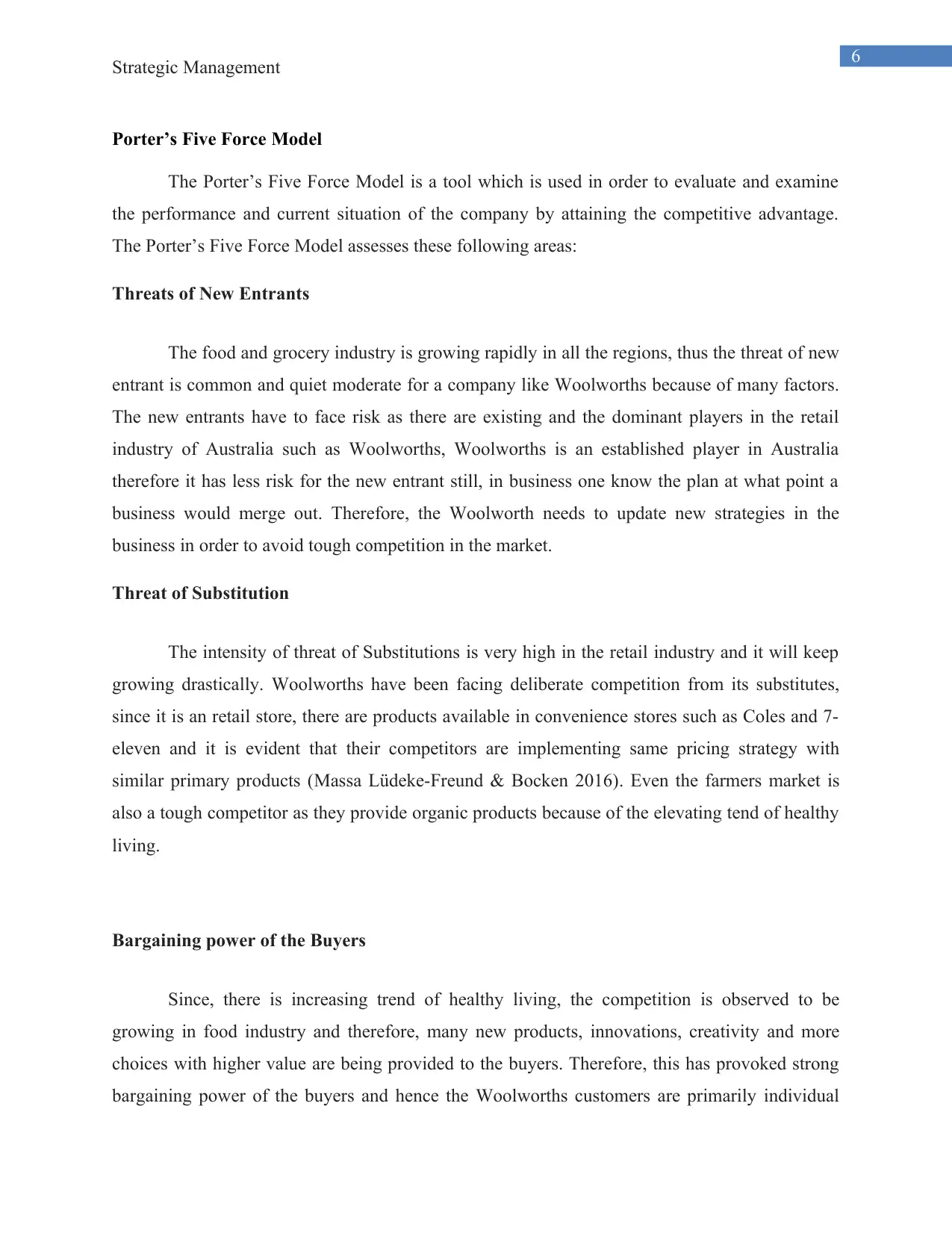
6
Strategic Management
Porter’s Five Force Model
The Porter’s Five Force Model is a tool which is used in order to evaluate and examine
the performance and current situation of the company by attaining the competitive advantage.
The Porter’s Five Force Model assesses these following areas:
Threats of New Entrants
The food and grocery industry is growing rapidly in all the regions, thus the threat of new
entrant is common and quiet moderate for a company like Woolworths because of many factors.
The new entrants have to face risk as there are existing and the dominant players in the retail
industry of Australia such as Woolworths, Woolworths is an established player in Australia
therefore it has less risk for the new entrant still, in business one know the plan at what point a
business would merge out. Therefore, the Woolworth needs to update new strategies in the
business in order to avoid tough competition in the market.
Threat of Substitution
The intensity of threat of Substitutions is very high in the retail industry and it will keep
growing drastically. Woolworths have been facing deliberate competition from its substitutes,
since it is an retail store, there are products available in convenience stores such as Coles and 7-
eleven and it is evident that their competitors are implementing same pricing strategy with
similar primary products (Massa Lüdeke-Freund & Bocken 2016). Even the farmers market is
also a tough competitor as they provide organic products because of the elevating tend of healthy
living.
Bargaining power of the Buyers
Since, there is increasing trend of healthy living, the competition is observed to be
growing in food industry and therefore, many new products, innovations, creativity and more
choices with higher value are being provided to the buyers. Therefore, this has provoked strong
bargaining power of the buyers and hence the Woolworths customers are primarily individual
Strategic Management
Porter’s Five Force Model
The Porter’s Five Force Model is a tool which is used in order to evaluate and examine
the performance and current situation of the company by attaining the competitive advantage.
The Porter’s Five Force Model assesses these following areas:
Threats of New Entrants
The food and grocery industry is growing rapidly in all the regions, thus the threat of new
entrant is common and quiet moderate for a company like Woolworths because of many factors.
The new entrants have to face risk as there are existing and the dominant players in the retail
industry of Australia such as Woolworths, Woolworths is an established player in Australia
therefore it has less risk for the new entrant still, in business one know the plan at what point a
business would merge out. Therefore, the Woolworth needs to update new strategies in the
business in order to avoid tough competition in the market.
Threat of Substitution
The intensity of threat of Substitutions is very high in the retail industry and it will keep
growing drastically. Woolworths have been facing deliberate competition from its substitutes,
since it is an retail store, there are products available in convenience stores such as Coles and 7-
eleven and it is evident that their competitors are implementing same pricing strategy with
similar primary products (Massa Lüdeke-Freund & Bocken 2016). Even the farmers market is
also a tough competitor as they provide organic products because of the elevating tend of healthy
living.
Bargaining power of the Buyers
Since, there is increasing trend of healthy living, the competition is observed to be
growing in food industry and therefore, many new products, innovations, creativity and more
choices with higher value are being provided to the buyers. Therefore, this has provoked strong
bargaining power of the buyers and hence the Woolworths customers are primarily individual
⊘ This is a preview!⊘
Do you want full access?
Subscribe today to unlock all pages.

Trusted by 1+ million students worldwide
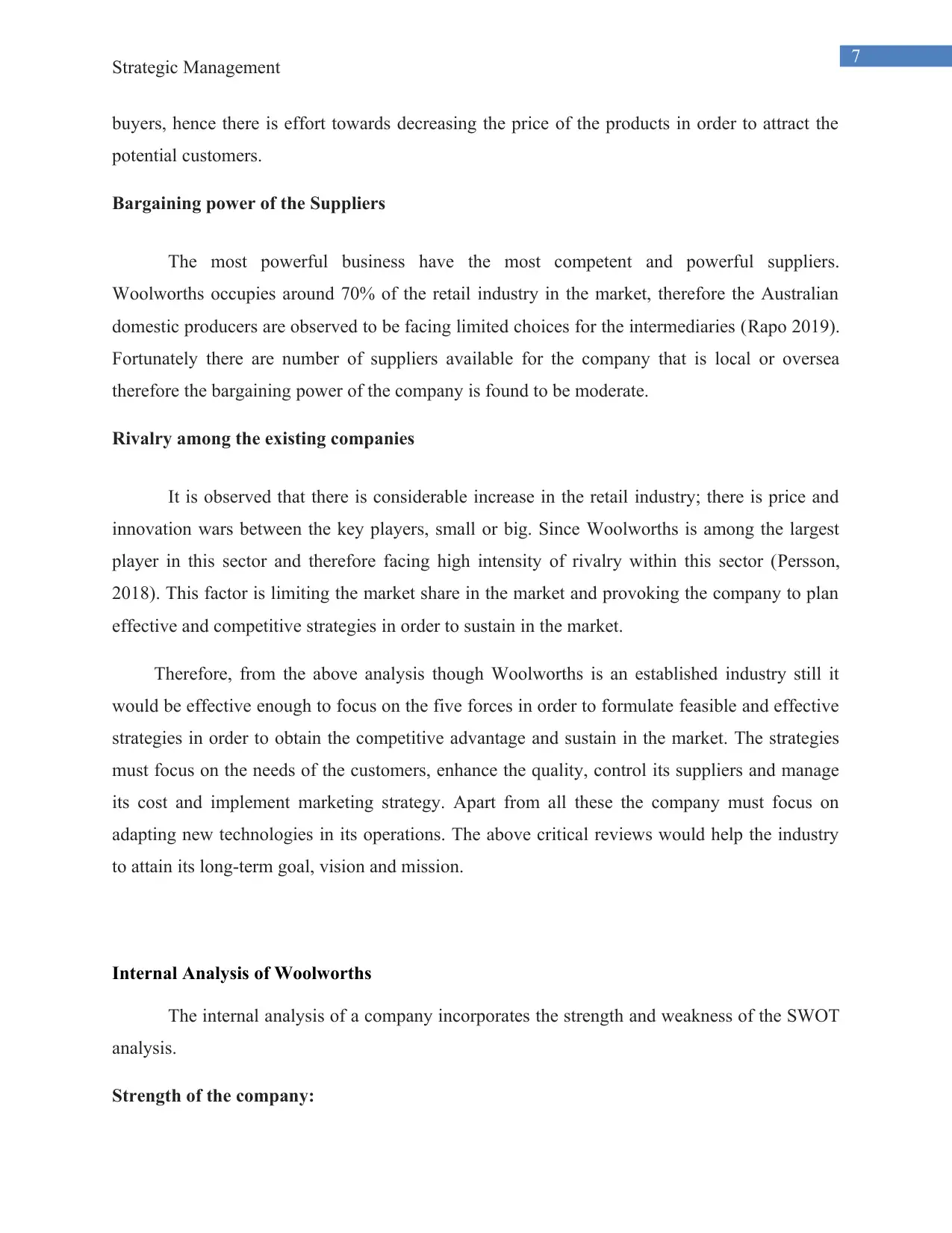
7
Strategic Management
buyers, hence there is effort towards decreasing the price of the products in order to attract the
potential customers.
Bargaining power of the Suppliers
The most powerful business have the most competent and powerful suppliers.
Woolworths occupies around 70% of the retail industry in the market, therefore the Australian
domestic producers are observed to be facing limited choices for the intermediaries (Rapo 2019).
Fortunately there are number of suppliers available for the company that is local or oversea
therefore the bargaining power of the company is found to be moderate.
Rivalry among the existing companies
It is observed that there is considerable increase in the retail industry; there is price and
innovation wars between the key players, small or big. Since Woolworths is among the largest
player in this sector and therefore facing high intensity of rivalry within this sector (Persson,
2018). This factor is limiting the market share in the market and provoking the company to plan
effective and competitive strategies in order to sustain in the market.
Therefore, from the above analysis though Woolworths is an established industry still it
would be effective enough to focus on the five forces in order to formulate feasible and effective
strategies in order to obtain the competitive advantage and sustain in the market. The strategies
must focus on the needs of the customers, enhance the quality, control its suppliers and manage
its cost and implement marketing strategy. Apart from all these the company must focus on
adapting new technologies in its operations. The above critical reviews would help the industry
to attain its long-term goal, vision and mission.
Internal Analysis of Woolworths
The internal analysis of a company incorporates the strength and weakness of the SWOT
analysis.
Strength of the company:
Strategic Management
buyers, hence there is effort towards decreasing the price of the products in order to attract the
potential customers.
Bargaining power of the Suppliers
The most powerful business have the most competent and powerful suppliers.
Woolworths occupies around 70% of the retail industry in the market, therefore the Australian
domestic producers are observed to be facing limited choices for the intermediaries (Rapo 2019).
Fortunately there are number of suppliers available for the company that is local or oversea
therefore the bargaining power of the company is found to be moderate.
Rivalry among the existing companies
It is observed that there is considerable increase in the retail industry; there is price and
innovation wars between the key players, small or big. Since Woolworths is among the largest
player in this sector and therefore facing high intensity of rivalry within this sector (Persson,
2018). This factor is limiting the market share in the market and provoking the company to plan
effective and competitive strategies in order to sustain in the market.
Therefore, from the above analysis though Woolworths is an established industry still it
would be effective enough to focus on the five forces in order to formulate feasible and effective
strategies in order to obtain the competitive advantage and sustain in the market. The strategies
must focus on the needs of the customers, enhance the quality, control its suppliers and manage
its cost and implement marketing strategy. Apart from all these the company must focus on
adapting new technologies in its operations. The above critical reviews would help the industry
to attain its long-term goal, vision and mission.
Internal Analysis of Woolworths
The internal analysis of a company incorporates the strength and weakness of the SWOT
analysis.
Strength of the company:
Paraphrase This Document
Need a fresh take? Get an instant paraphrase of this document with our AI Paraphraser

8
Strategic Management
The Woolworthss is well-known company in the retail industry with over more
than 900 stores as well as it is oldest company in Australia which enabled to introduce modern
retail trading model. The company has several schemes on brand loyalty in order to gain
customer attention and for its regular potential customers as well. Woolworths possess strong
brand name and with efficient operations. The company possesses many private level brands
which is quite popular among the customers. Woolworths serves around more than 1.8 million
customers that is every week. Moreover, “Woolworth’s has been rewarded in Australia as the
most attractive supermarket loyalty program”. This makes customers aware of the supermarket
and makes them buy from that particular palce. This makes Woolworths as Australia’s Fresh
Food People. The company is one of the Australia’s most creative and innovative retailer, it tries
to make it easier for the customers to shop and get the best quality product in Australia.
Customers can shop online, there a particular app for the supermarket. . In current status, the
Australia retail industry has incorporated more stability, and hence supporting Woolworths in
effective continuation of the business. It is also the largest retail store in Australia. Woolworths
have the efficient and experienced employees which increases the work efficiency. As estimation
the company has around 205,000 employees and it is estimated that with passing years and the
company’s expansion the company continues to open more branches (Woolworths SWOT
Analysis, 2019).
Weakness of the Company
The Woolworths faces confused positioning, that is using the same product targeting
multiple income segments (Indris & Primiana 2015). Due to this it unintentionally delivers
confused signals to its customers, the customers are not sure whether the market offers value
prices. The company faces strong bargaining power of the customers. Often it has failed to attain
the competitive advantage (Cole).The company faces limited market share in limited
geographical area. The competitive advantage that is evolved from the cost-based rather than
focusing on differentiation based factors. The Woolworths primary compete based upon the price
not the quality of product and service. It is unable to support the higher growth level the level of
Strategic Management
The Woolworthss is well-known company in the retail industry with over more
than 900 stores as well as it is oldest company in Australia which enabled to introduce modern
retail trading model. The company has several schemes on brand loyalty in order to gain
customer attention and for its regular potential customers as well. Woolworths possess strong
brand name and with efficient operations. The company possesses many private level brands
which is quite popular among the customers. Woolworths serves around more than 1.8 million
customers that is every week. Moreover, “Woolworth’s has been rewarded in Australia as the
most attractive supermarket loyalty program”. This makes customers aware of the supermarket
and makes them buy from that particular palce. This makes Woolworths as Australia’s Fresh
Food People. The company is one of the Australia’s most creative and innovative retailer, it tries
to make it easier for the customers to shop and get the best quality product in Australia.
Customers can shop online, there a particular app for the supermarket. . In current status, the
Australia retail industry has incorporated more stability, and hence supporting Woolworths in
effective continuation of the business. It is also the largest retail store in Australia. Woolworths
have the efficient and experienced employees which increases the work efficiency. As estimation
the company has around 205,000 employees and it is estimated that with passing years and the
company’s expansion the company continues to open more branches (Woolworths SWOT
Analysis, 2019).
Weakness of the Company
The Woolworths faces confused positioning, that is using the same product targeting
multiple income segments (Indris & Primiana 2015). Due to this it unintentionally delivers
confused signals to its customers, the customers are not sure whether the market offers value
prices. The company faces strong bargaining power of the customers. Often it has failed to attain
the competitive advantage (Cole).The company faces limited market share in limited
geographical area. The competitive advantage that is evolved from the cost-based rather than
focusing on differentiation based factors. The Woolworths primary compete based upon the price
not the quality of product and service. It is unable to support the higher growth level the level of
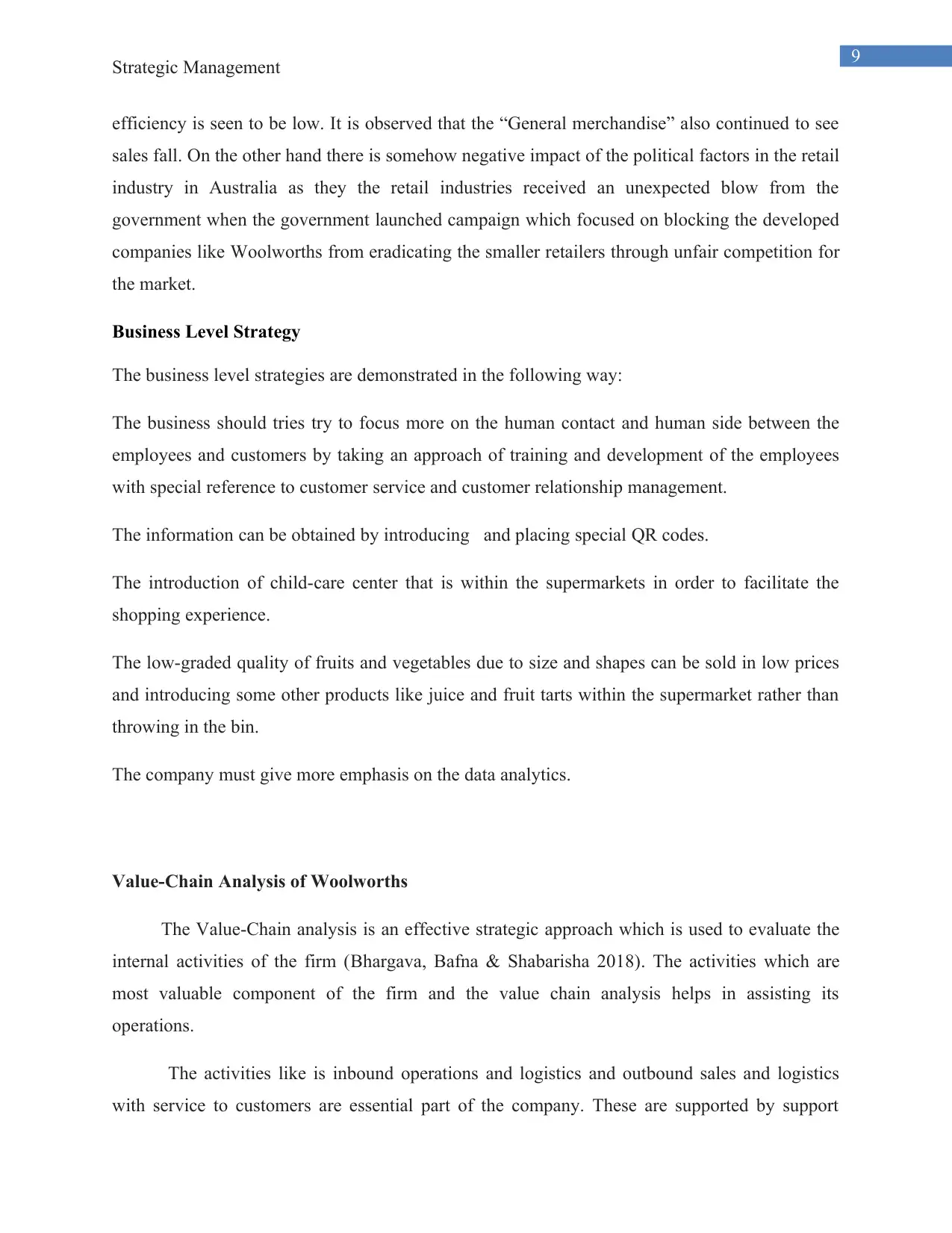
9
Strategic Management
efficiency is seen to be low. It is observed that the “General merchandise” also continued to see
sales fall. On the other hand there is somehow negative impact of the political factors in the retail
industry in Australia as they the retail industries received an unexpected blow from the
government when the government launched campaign which focused on blocking the developed
companies like Woolworths from eradicating the smaller retailers through unfair competition for
the market.
Business Level Strategy
The business level strategies are demonstrated in the following way:
The business should tries try to focus more on the human contact and human side between the
employees and customers by taking an approach of training and development of the employees
with special reference to customer service and customer relationship management.
The information can be obtained by introducing and placing special QR codes.
The introduction of child-care center that is within the supermarkets in order to facilitate the
shopping experience.
The low-graded quality of fruits and vegetables due to size and shapes can be sold in low prices
and introducing some other products like juice and fruit tarts within the supermarket rather than
throwing in the bin.
The company must give more emphasis on the data analytics.
Value-Chain Analysis of Woolworths
The Value-Chain analysis is an effective strategic approach which is used to evaluate the
internal activities of the firm (Bhargava, Bafna & Shabarisha 2018). The activities which are
most valuable component of the firm and the value chain analysis helps in assisting its
operations.
The activities like is inbound operations and logistics and outbound sales and logistics
with service to customers are essential part of the company. These are supported by support
Strategic Management
efficiency is seen to be low. It is observed that the “General merchandise” also continued to see
sales fall. On the other hand there is somehow negative impact of the political factors in the retail
industry in Australia as they the retail industries received an unexpected blow from the
government when the government launched campaign which focused on blocking the developed
companies like Woolworths from eradicating the smaller retailers through unfair competition for
the market.
Business Level Strategy
The business level strategies are demonstrated in the following way:
The business should tries try to focus more on the human contact and human side between the
employees and customers by taking an approach of training and development of the employees
with special reference to customer service and customer relationship management.
The information can be obtained by introducing and placing special QR codes.
The introduction of child-care center that is within the supermarkets in order to facilitate the
shopping experience.
The low-graded quality of fruits and vegetables due to size and shapes can be sold in low prices
and introducing some other products like juice and fruit tarts within the supermarket rather than
throwing in the bin.
The company must give more emphasis on the data analytics.
Value-Chain Analysis of Woolworths
The Value-Chain analysis is an effective strategic approach which is used to evaluate the
internal activities of the firm (Bhargava, Bafna & Shabarisha 2018). The activities which are
most valuable component of the firm and the value chain analysis helps in assisting its
operations.
The activities like is inbound operations and logistics and outbound sales and logistics
with service to customers are essential part of the company. These are supported by support
⊘ This is a preview!⊘
Do you want full access?
Subscribe today to unlock all pages.

Trusted by 1+ million students worldwide
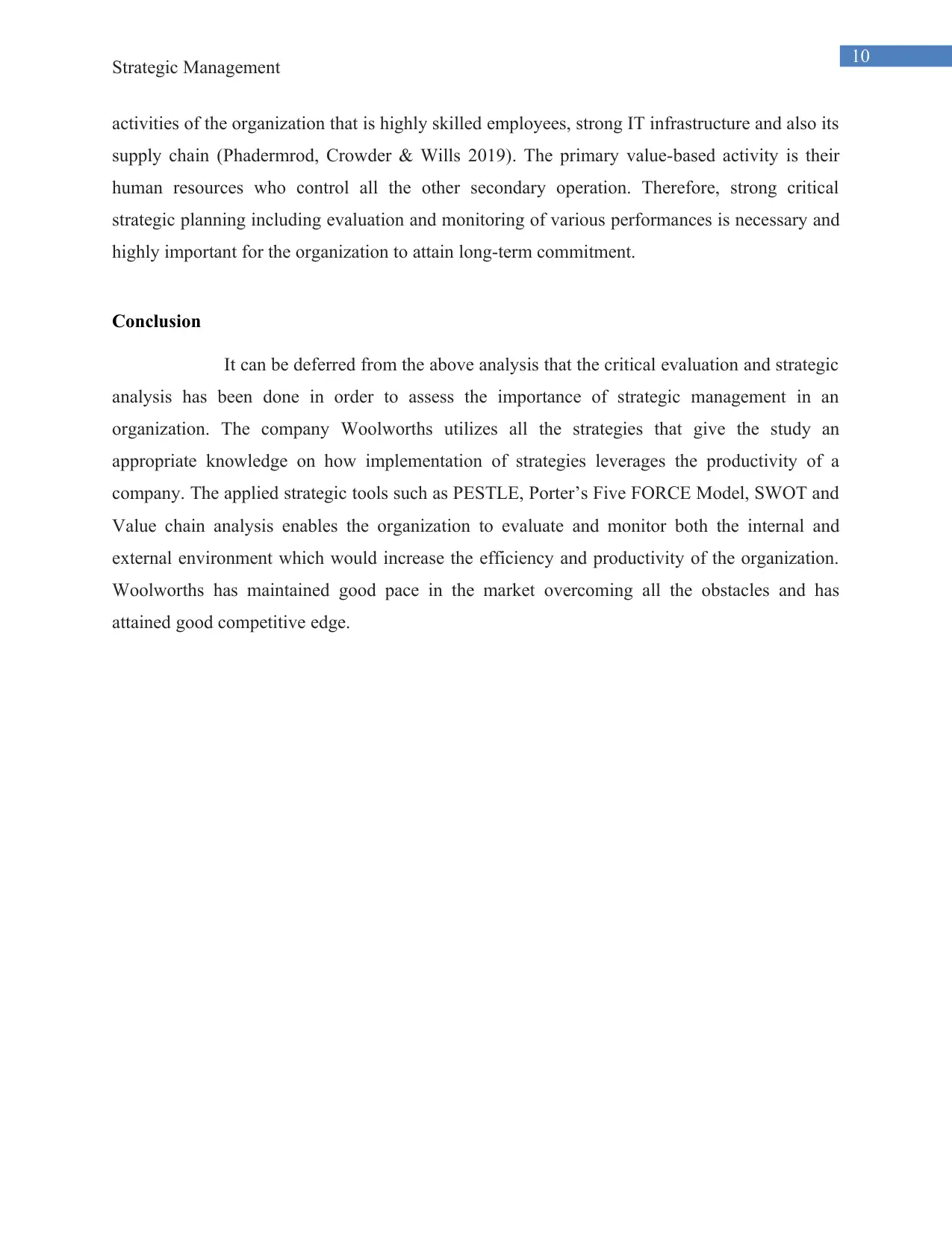
10
Strategic Management
activities of the organization that is highly skilled employees, strong IT infrastructure and also its
supply chain (Phadermrod, Crowder & Wills 2019). The primary value-based activity is their
human resources who control all the other secondary operation. Therefore, strong critical
strategic planning including evaluation and monitoring of various performances is necessary and
highly important for the organization to attain long-term commitment.
Conclusion
It can be deferred from the above analysis that the critical evaluation and strategic
analysis has been done in order to assess the importance of strategic management in an
organization. The company Woolworths utilizes all the strategies that give the study an
appropriate knowledge on how implementation of strategies leverages the productivity of a
company. The applied strategic tools such as PESTLE, Porter’s Five FORCE Model, SWOT and
Value chain analysis enables the organization to evaluate and monitor both the internal and
external environment which would increase the efficiency and productivity of the organization.
Woolworths has maintained good pace in the market overcoming all the obstacles and has
attained good competitive edge.
Strategic Management
activities of the organization that is highly skilled employees, strong IT infrastructure and also its
supply chain (Phadermrod, Crowder & Wills 2019). The primary value-based activity is their
human resources who control all the other secondary operation. Therefore, strong critical
strategic planning including evaluation and monitoring of various performances is necessary and
highly important for the organization to attain long-term commitment.
Conclusion
It can be deferred from the above analysis that the critical evaluation and strategic
analysis has been done in order to assess the importance of strategic management in an
organization. The company Woolworths utilizes all the strategies that give the study an
appropriate knowledge on how implementation of strategies leverages the productivity of a
company. The applied strategic tools such as PESTLE, Porter’s Five FORCE Model, SWOT and
Value chain analysis enables the organization to evaluate and monitor both the internal and
external environment which would increase the efficiency and productivity of the organization.
Woolworths has maintained good pace in the market overcoming all the obstacles and has
attained good competitive edge.
Paraphrase This Document
Need a fresh take? Get an instant paraphrase of this document with our AI Paraphraser
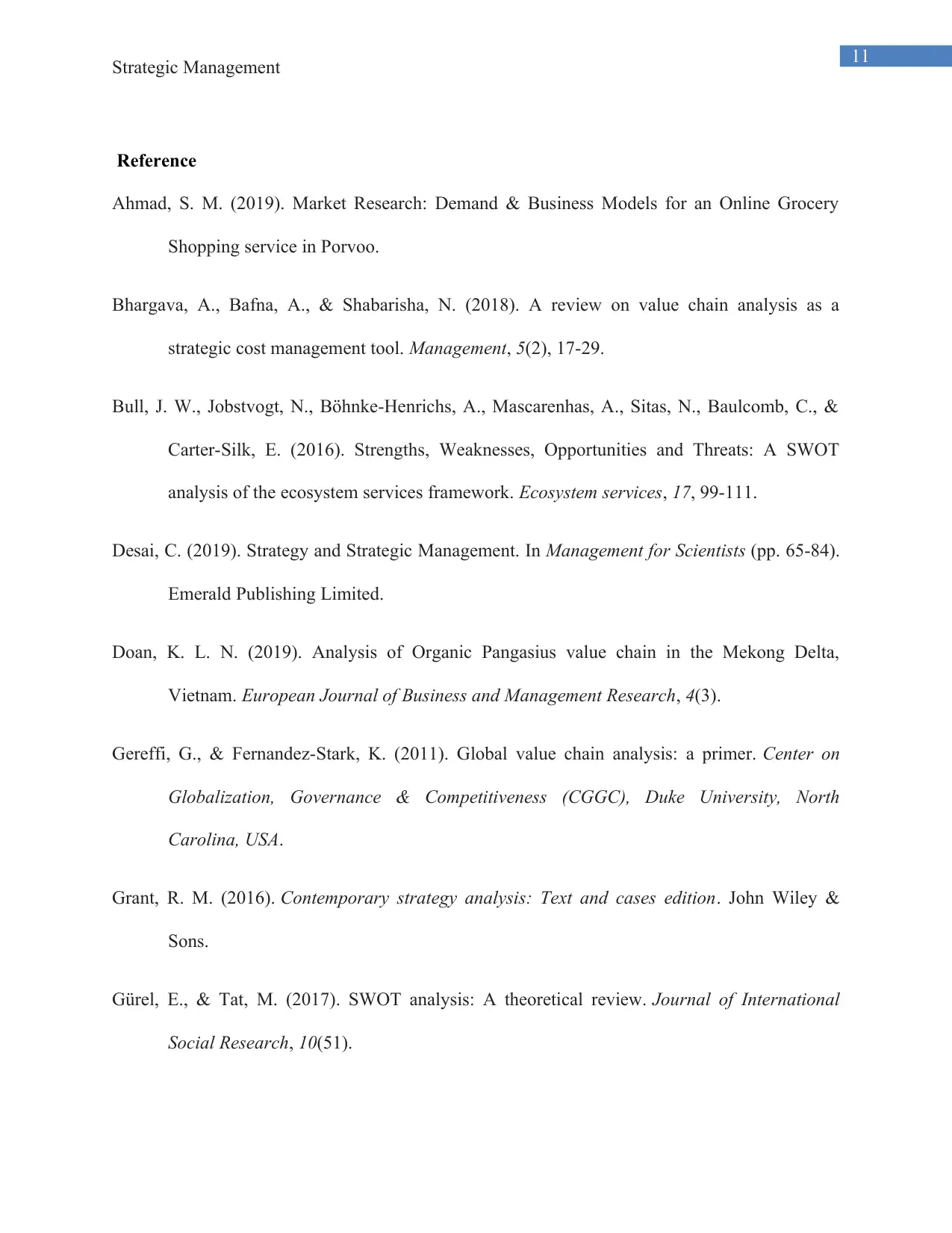
11
Strategic Management
Reference
Ahmad, S. M. (2019). Market Research: Demand & Business Models for an Online Grocery
Shopping service in Porvoo.
Bhargava, A., Bafna, A., & Shabarisha, N. (2018). A review on value chain analysis as a
strategic cost management tool. Management, 5(2), 17-29.
Bull, J. W., Jobstvogt, N., Böhnke-Henrichs, A., Mascarenhas, A., Sitas, N., Baulcomb, C., &
Carter-Silk, E. (2016). Strengths, Weaknesses, Opportunities and Threats: A SWOT
analysis of the ecosystem services framework. Ecosystem services, 17, 99-111.
Desai, C. (2019). Strategy and Strategic Management. In Management for Scientists (pp. 65-84).
Emerald Publishing Limited.
Doan, K. L. N. (2019). Analysis of Organic Pangasius value chain in the Mekong Delta,
Vietnam. European Journal of Business and Management Research, 4(3).
Gereffi, G., & Fernandez-Stark, K. (2011). Global value chain analysis: a primer. Center on
Globalization, Governance & Competitiveness (CGGC), Duke University, North
Carolina, USA.
Grant, R. M. (2016). Contemporary strategy analysis: Text and cases edition. John Wiley &
Sons.
Gürel, E., & Tat, M. (2017). SWOT analysis: A theoretical review. Journal of International
Social Research, 10(51).
Strategic Management
Reference
Ahmad, S. M. (2019). Market Research: Demand & Business Models for an Online Grocery
Shopping service in Porvoo.
Bhargava, A., Bafna, A., & Shabarisha, N. (2018). A review on value chain analysis as a
strategic cost management tool. Management, 5(2), 17-29.
Bull, J. W., Jobstvogt, N., Böhnke-Henrichs, A., Mascarenhas, A., Sitas, N., Baulcomb, C., &
Carter-Silk, E. (2016). Strengths, Weaknesses, Opportunities and Threats: A SWOT
analysis of the ecosystem services framework. Ecosystem services, 17, 99-111.
Desai, C. (2019). Strategy and Strategic Management. In Management for Scientists (pp. 65-84).
Emerald Publishing Limited.
Doan, K. L. N. (2019). Analysis of Organic Pangasius value chain in the Mekong Delta,
Vietnam. European Journal of Business and Management Research, 4(3).
Gereffi, G., & Fernandez-Stark, K. (2011). Global value chain analysis: a primer. Center on
Globalization, Governance & Competitiveness (CGGC), Duke University, North
Carolina, USA.
Grant, R. M. (2016). Contemporary strategy analysis: Text and cases edition. John Wiley &
Sons.
Gürel, E., & Tat, M. (2017). SWOT analysis: A theoretical review. Journal of International
Social Research, 10(51).
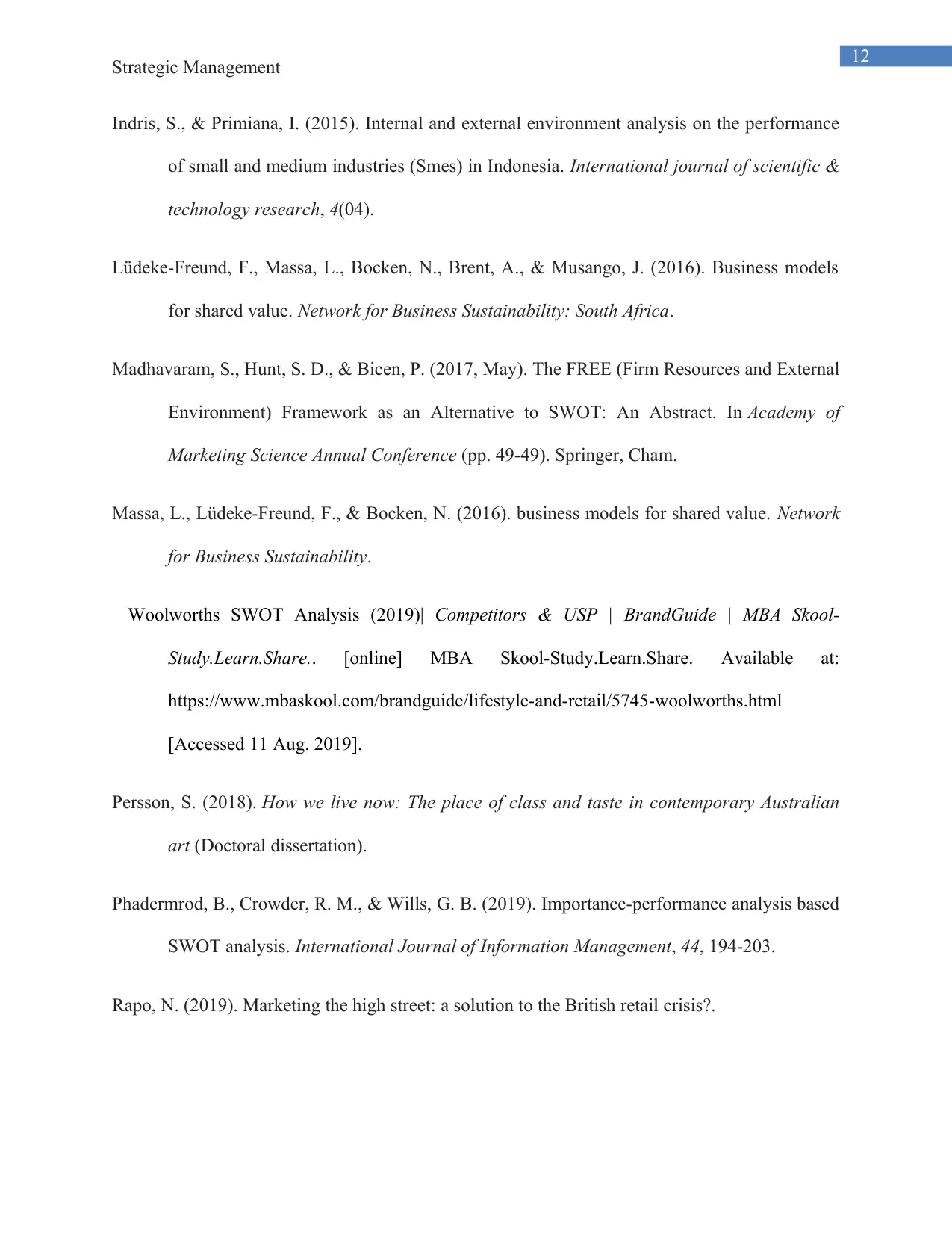
12
Strategic Management
Indris, S., & Primiana, I. (2015). Internal and external environment analysis on the performance
of small and medium industries (Smes) in Indonesia. International journal of scientific &
technology research, 4(04).
Lüdeke-Freund, F., Massa, L., Bocken, N., Brent, A., & Musango, J. (2016). Business models
for shared value. Network for Business Sustainability: South Africa.
Madhavaram, S., Hunt, S. D., & Bicen, P. (2017, May). The FREE (Firm Resources and External
Environment) Framework as an Alternative to SWOT: An Abstract. In Academy of
Marketing Science Annual Conference (pp. 49-49). Springer, Cham.
Massa, L., Lüdeke-Freund, F., & Bocken, N. (2016). business models for shared value. Network
for Business Sustainability.
Woolworths SWOT Analysis (2019)| Competitors & USP | BrandGuide | MBA Skool-
Study.Learn.Share.. [online] MBA Skool-Study.Learn.Share. Available at:
https://www.mbaskool.com/brandguide/lifestyle-and-retail/5745-woolworths.html
[Accessed 11 Aug. 2019].
Persson, S. (2018). How we live now: The place of class and taste in contemporary Australian
art (Doctoral dissertation).
Phadermrod, B., Crowder, R. M., & Wills, G. B. (2019). Importance-performance analysis based
SWOT analysis. International Journal of Information Management, 44, 194-203.
Rapo, N. (2019). Marketing the high street: a solution to the British retail crisis?.
Strategic Management
Indris, S., & Primiana, I. (2015). Internal and external environment analysis on the performance
of small and medium industries (Smes) in Indonesia. International journal of scientific &
technology research, 4(04).
Lüdeke-Freund, F., Massa, L., Bocken, N., Brent, A., & Musango, J. (2016). Business models
for shared value. Network for Business Sustainability: South Africa.
Madhavaram, S., Hunt, S. D., & Bicen, P. (2017, May). The FREE (Firm Resources and External
Environment) Framework as an Alternative to SWOT: An Abstract. In Academy of
Marketing Science Annual Conference (pp. 49-49). Springer, Cham.
Massa, L., Lüdeke-Freund, F., & Bocken, N. (2016). business models for shared value. Network
for Business Sustainability.
Woolworths SWOT Analysis (2019)| Competitors & USP | BrandGuide | MBA Skool-
Study.Learn.Share.. [online] MBA Skool-Study.Learn.Share. Available at:
https://www.mbaskool.com/brandguide/lifestyle-and-retail/5745-woolworths.html
[Accessed 11 Aug. 2019].
Persson, S. (2018). How we live now: The place of class and taste in contemporary Australian
art (Doctoral dissertation).
Phadermrod, B., Crowder, R. M., & Wills, G. B. (2019). Importance-performance analysis based
SWOT analysis. International Journal of Information Management, 44, 194-203.
Rapo, N. (2019). Marketing the high street: a solution to the British retail crisis?.
⊘ This is a preview!⊘
Do you want full access?
Subscribe today to unlock all pages.

Trusted by 1+ million students worldwide
1 out of 12
Related Documents
Your All-in-One AI-Powered Toolkit for Academic Success.
+13062052269
info@desklib.com
Available 24*7 on WhatsApp / Email
![[object Object]](/_next/static/media/star-bottom.7253800d.svg)
Unlock your academic potential
Copyright © 2020–2025 A2Z Services. All Rights Reserved. Developed and managed by ZUCOL.




